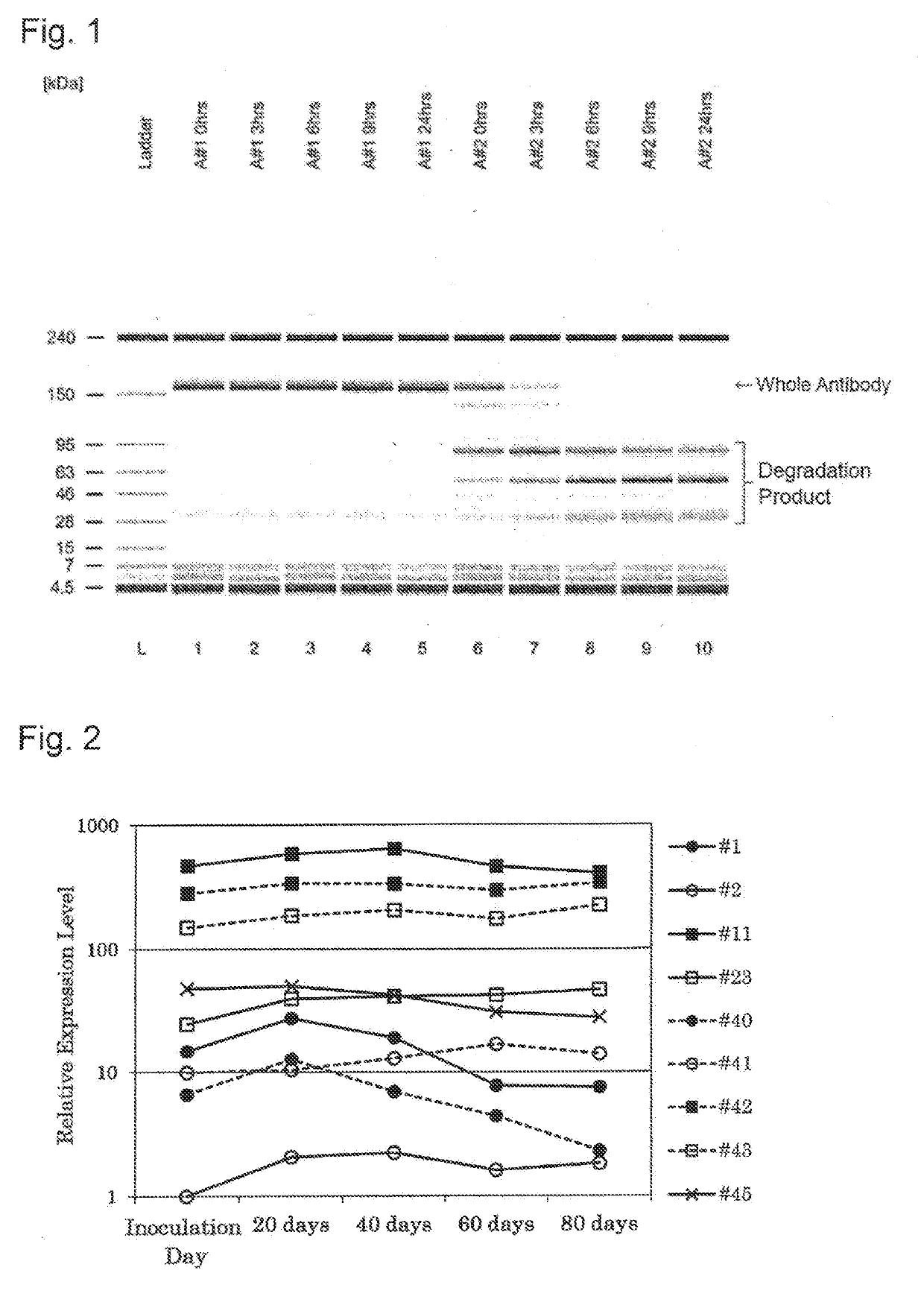Method for selecting cell
a cell and cell technology, applied in the field of cell selection, can solve the problems of reducing the growth rate of production cells, not being able to evaluate and select a large number of cells, and not yet being able to achieve the effect of suppressing the activity of reducing activity against a target protein, easy selection, and high probability
- Summary
- Abstract
- Description
- Claims
- Application Information
AI Technical Summary
Benefits of technology
Problems solved by technology
Method used
Image
Examples
example 1
Gene Expression Difference Analysis of Antibody-Producing Cell Using Microarray Analysis
[0154]A gene expression difference analysis using a DNA microarray was performed for the purpose of specifying a gene (mRNA) expressed correlatively with a difference in ease of reduction of a protein (antibody) to be produced.
[0155]Cells in which an antibody to be produced is not easily reduced [a CHO cell #1 producing an IgG4-type monoclonal antibody (hereinafter referred to as “antibody A”) (hereinafter abbreviated as “A#1 strain”), and a CHO cell #1 producing an IgG1 / IgG3 chimeric monoclonal antibody (hereinafter referred to as “antibody B”) (hereinafter abbreviated as “B#1 strain”)] that is an antibody against an antigen different from the antibody A, and cells in which an antibody to be produced is easily reduced [a CHO cell #2 producing the antibody A (hereinafter abbreviated as “A#2 strain”), and a CHO cell #2 producing the antibody B (hereinafter abbreviated as “B#2 strain”)] were used f...
example 2
Determination of Ease of Reduction of Production Cell by Expression Difference Analysis of Placenta-Expressed Transcript 1 Protein (hereinafter referred to as Plet1) Gene Using RT-qPCR Method
[0164]The following analysis was performed using Plet1 gene that was revealed to be highly expressed in a production strain in which a protein to be produced is not easily reduced among the genes found in Example 1 as an example.
[0165]With respect to the total RNA obtained from four types of cells (Table 1) prepared in Example 1 and used in the microarray analysis, the expression level of a gene was analyzed by the following method using the RT-qPCR method. First, based on the information of the base sequence of Plet1 gene of a Chinese hamster, a probe and primers to be used in the RT-qPCR method were designed (Table 3, SEQ ID NOS: 3 to 5).
[0166]A reaction solution was prepared as 20 μL of a reaction system containing 5 μL of TaqMan Fast Virus 1-Step Master Mix (manufactured by Thermo Fisher Sci...
example 3
Selection of Production Cell in which Protein is Not Easily Reduced by Expression Difference Analysis of Plet1 Gene
[0170]Chinese hamster ovary-derived cells (CHO cells) were acclimated in a serum-free medium, whereby host cells X were obtained. By using the method described in U.S. Pat. No. 6,946,292, CHO cells in which fucosyltransferase (FUT8) was deleted were obtained and used as host cells Y.
[0171]Subsequently, the host cells Y were suspended in PBS, and gene transfer was performed using an expression vector integrated with a gene of an IgG1-type monoclonal antibody (hereinafter referred to as“antibody C”) that is an antibody against an antigen different from the antibody A or the antibody B.
[0172]After gene transfer by electroporation, the cells in a cuvette were suspended in a medium and inoculated into a 96-well plate and cultured in a CO2 incubator for a few days. Subsequently, after a few days from the gene transfer, the medium was exchanged with a medium containing cyclohe...
PUM
| Property | Measurement | Unit |
|---|---|---|
| Level | aaaaa | aaaaa |
Abstract
Description
Claims
Application Information
 Login to View More
Login to View More - R&D
- Intellectual Property
- Life Sciences
- Materials
- Tech Scout
- Unparalleled Data Quality
- Higher Quality Content
- 60% Fewer Hallucinations
Browse by: Latest US Patents, China's latest patents, Technical Efficacy Thesaurus, Application Domain, Technology Topic, Popular Technical Reports.
© 2025 PatSnap. All rights reserved.Legal|Privacy policy|Modern Slavery Act Transparency Statement|Sitemap|About US| Contact US: help@patsnap.com

